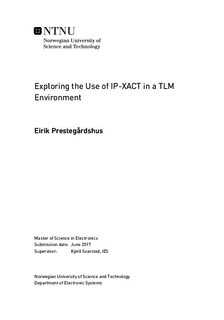Exploring the Use of IP-XACT in a TLM Environment
Master thesis
Permanent lenke
http://hdl.handle.net/11250/2457834Utgivelsesdato
2017Metadata
Vis full innførselSamlinger
Sammendrag
As both semiconductor technology and industry evolves, the need for robust methodologies and efficient design flows becomes more and more important. This thesis investigates IP-XACT, which is a standard that describes metadata of electronic systems aimed at computer-aided designs. The thesis emphasises methodologies of IP-XACT, as well as the overall structure and execution of said methodologies. The thesis carries out an experiment where IP-XACT is used with transactional-level modelling (TLM). The experiment emphasises methodologies, implementation and structure of the standard. IP-XACT fully accomplishes to describe a component s metadata, and additionally serve as very valuable to the entire design flow and as a back-end metadata organisation. Study and experimentation show the methodologies and core metadata description to be strong concepts, but criticise lacking vendor neutrality and an unintuitive mixed-model structure. To solve the discovered weaknesses, the thesis proposes an alternative model that restructure elements that describe information specific to models (like TLM). IP-XACT is ready to be used in the design flow, but is still a subject of development, thus feedback can prove very valuable for future versions. IP-XACT seemingly has a positive future to come, especially with the industry being more reliant on computer-aided design flows to achieve higher levels of efficiency.
